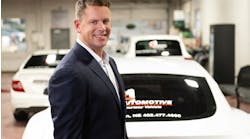Greg Sands has built an empire on saying “yes.” A former restaurateur, Sands brought many of the customer-centric business philosophies from the restaurant world to auto repair, eventually creating a multimillion dollar empire across the South and Southwest and opening and selling more than 80 repair shops in his career.
The crux of his philosophy comes down to what he calls a “yes” mentality.
“Being a ‘yes’ company is saying ‘yes’ to whatever the customer wants,” Sands says. “And I don’t mean the price; it’s really more about the timing.”
Becoming a “yes” company, Sands says, is about making the customer walking through the front door the priority, not turning away work and being available when the customer needs you. It also means getting the customer to say “yes” during the sales conversation, he says.
While it’s been a large part of Sands’ auto repair success, he’s heard criticism from those who misunderstand the premise. The concerns? It’s a chain-shop mentality, attracts bottom feeders, overextends the shop, produces low average repair order (ARO) and is logistically difficult.
That couldn’t be further from the truth, Sands says. And His shops are proof of that.
Then there’s Brian Sump. The owner of Avalon Motorsports in Denver, Sump runs a German automotive specialty facility, one with high ARO and an eye for attracting high-end customers. Not exactly what many might picture from a “yes” shop. And yet, two years ago, Sump realized the concept was right for his business.
“[Customers] call you and if you aren’t able to get them in or there’s something that pushes them off, there’s a high likelihood that they’re going to go elsewhere and you’re never going to get a chance to serve them again,” says Sump. “We realized that being booked out a week or two like we were wasn’t necessarily a good thing. We needed to take that seriously.”
Sump says the change has been more than worthwhile—and he’s proof that the concept can work in any shop, regardless of niche, market or specialty. He and Sands outline the seven steps that any shop can take to start becoming a “yes” company.
1) CHANGE YOUR PHILOSOPHY. Switching to being a “yes” company is all about priority, Sands says, especially as that priority relates to customer service. As a shop you have a choice of two priorities: the cars that are already in the shop and the customers coming in the front door.
“You’ve already sold the cars that are in the shop, so when a customer comes through the front door—even if you have to push a car out of the shop to look at a new car—you always want to check out the car coming through the door,” he says. “If you check it out, diagnose the car, they’re more likely going to keep it with you.”
When a customer calls and asks if they can bring their car in, Sands says you should say, “Absolutely, is now a good time to bring in your vehicle?” The customer will decide if now is a good time or not, he says, but the point is to make sure that you’re working around the customer’s schedule, not the other way around. That mentality is a big change from the traditional mentality, and Sands says you need to start talking to your staff and getting them to understand why fitting customers in immediately is beneficial.
2) GET STAFF TO COMMIT. The biggest mistake that shops make when switching to being a “yes” company is that the staff, especially service advisors, don’t fully commit and end up turning work away later in the day when the shop is busy, according to Sands. You need to get staff to commit, so start slowly engraining this concept in their minds. Sump says he has done so by making the philosophy a part of discussions at staff meetings.
“We started telling stories of other companies that we felt exemplified what a ‘yes’ company was,” he says. “It takes a lot of vision casting and following up to impart the culture you want to have. Any little chance you have to teach, you start to explain or challenge the ‘why’ behind processes, where they’re broken or flawed. It’s a lot of repetition and pointing out, when they do it, why there was merit or benefit in that.”
3) CREATE A CUSTOMER PATHWAY. Sands designed a “customer pathway” years ago to help his shops identify every aspect of their jobs where they may interact with a customer—from the moment they pull in the parking lot or call to the moment they drive away—and have a process in place to handle each touch point.
The purpose, he says, is to create this pathway with your staff, make sure that each process says “yes” to the customer and explain how to interact with them in those situations. For example, Sump has a list of specialists that his staff can refer to when customers make common requests that his shop can't accommodate.
“What I would recommend is that you start by recording all your phone calls coming in,” Sands says. “You should listen to those calls and make sure that when a customer calls your shop, that you act interested in them coming in today.”
4) MARKET TO THE RIGHT CUSTOMERS. Before you say “yes” to the customer, you need to get the right kind of customers in your shop. Sands says that your marketing needs to target specific demographics to ensure you attract the best customers— the ones you would actually want to say “yes” to. First, he says you should always advertise within two miles of your shop.
“Even if you think a market is better, there are still good people within two miles around any shop. The closer you mail to your shop, the more customers you’re going to get,” he says. “Then you can raise your target. We may say, ‘We’re only going to mail to people that make $50,000 and up.’”
Sands says the best way to tell if they’re a good customer is by their comments upon calling in. One of the biggest misconceptions about the “yes” mentality is that shops will be giving money away. It’s actually the opposite, says Sands.
“What’s misunderstood is that the good paying customers are the ones in a hurry. Their time is worth more than their money. It’s the customers that give you all day that may not spend money for you. They’ll shop to get the cheapest prices,” he says. “Are they in a hurry? If they are, we know they are good customers. If they’re saying, ‘How much?’, then that’s not our customer.”
5) UNDERSTAND YOUR SHOP’S CAPACITY. Sands says it’s a fact of being a “yes” company: If you say “yes” to customers, you will be overwhelmed some days.
Start by evaluating your current staff and equipment. See where inefficiencies occur throughout your repair process and also consider your ability to expand or redesign your building.
“You have to experiment a little with your situation and know, how many lifts do I have in my facility? Am I land locked or can I expand?” says Sump. “You have to start strategizing logistically. If I have the same number of techs and I want to add more cars, instead of being three days out, you’re going to be five days out.”
The way to tell you are ready to add staff, Sands says, is when you are consistently overwhelmed and unable to get the work done every day.
“If work comes in on Monday and you’re not getting it out by Wednesday, you are then really understaffed,” he says. “You want to be working on Wednesday’s work on Wednesday. You don’t want to be working on Monday’s work on Wednesday. If you become a true “yes” company, your shop will get overwhelmed in a matter of weeks.”
Sump added another technician and a lift because his existing three techs were already flagging the maximum amount of hours they could per month. It is a bit of a horse-and-cart game, Sump says, but you need to determine your capacity, or “where the walls shake.”
“Even being a 'yes' company, you still have a capacity,” he says. “You have to know what that is and when things start falling through the cracks.”
6) GET THE LOGISTICS DOWN. Speed will dramatically affect whether the customer is going to buy from your shop or not, Sands says.
“If a customer drops off a car in the morning and we can call him back with a diagnosis in a couple hours, our chances of selling that job is almost 100 percent,” he says. “If it starts getting late in the morning or early afternoon, our chances go down because the customer is starting to worry they won’t get their car back. Even if they do the repair they came in for, they probably aren’t going to do any additional services for fear that they’re not going to get their car back in time.”
That’s why the priority needs to be getting the car in and diagnosed as quickly as possible, even if that means taking another car out of the bay.
“The industry might confuse a good customer with what they call a bottom feeder,” says Sands. “A good customer, because they’re worried about time, they’ll walk into your shop and their questions are about time. A shop owner might think they’re in a hurry and they don’t want to spend any money. In fact, it’s the opposite. Their time is worth more than their money. When they come in saying how long, that’s a signal to you that you have to say, ‘Is now a good time? We will make room for you.’ If you do that, you’re going to get the best customers out there.”
The way to determine which car to pull out of the bay or which technician to give the vehicle to comes back to prioritizing. Both Sump and Sands tout the value of customer shuttles and free rental cars in helping you do that.
“It allows you to stretch the rubber band really tightly,” says Sump, whose shop has 10 loaner vehicles and a negotiated rate with Enterprise in case of overflow. “The rental car situation allowed us to get people in and get their car here.”
Sands says that once customers are out of the shop, that gives you a chance to prioritize the overrun back of the shop. If someone is in the lobby waiting for their vehicle, they become the priority. You want to get their car checked out and send them on their way. But, if a customer was given a ride to work or has a rental car, they’re not the immediate priority.
It’s all about problem solving, Sump says, and figuring out the customer’s root need. It doesn’t do any good to say “yes” and then not deliver, he says. Instead, work together with the customer to find a solution they are comfortable with, whether that’s a rental car, coming in tomorrow, or if need be, prioritizing that customer.
7) TEACH YOUR CUSTOMERS THAT YOU’RE A “YES” COMPANY. Customers don’t automatically know from the get-go that they can count on your shop to be a “yes” company. Sands says you need to engrain the process in other ways to customers so they know you’re a “yes” company and can call you for any needs. That could be done through marketing, social media and consistency during the customer service experience.
How to Say “Yes” During Busy Days
Saying “yes” is easy when the shop is slow. But on busy days? That’s when it becomes more difficult. Sands says one of the biggest reasons why shops fail at truly being a “yes” company is because they turn away work when the shop gets busy. Sump provides an example of how he deals with a customer when the shop is already busy.



